With World Environment Day just around the corner (June 5th), what better time to explore the conclusions of a recent and sobering United Nations report on biodiversity and ecosystem services.
Released in May this year, the summary version of the report contains some startling statistics. For example, nature is declining globally at rates unprecedented in human history; unless we take urgent action, around 1 million animal and plant species may become extinct – many within decades.
The report also ranks, in descending order, the top five factors negatively impacting nature. Changes in land and sea use hold first place. Others, unsurprisingly, are climate change and pollution.
So what can a look at the interconnected data in Dimensions tell us? In this post, we consider the hot research topics in biodiversity and ecology, who’s writing about them, and how their findings are being funded and used.
Why are biodiversity and ecosystems so important?
Biodiversity refers to the variety and variability of life on Earth. A high level of biodiversity is considered crucial, not only to preserve a healthy balance of the ecosystem, i.e., how organisms interact with each other and their physical environment, but the delivery of ecosystem services.
The Encyclopedia of Environmental Health defines these ecosystem services as “direct benefits that humans obtain from the ecosystem, such as food and clean water, or indirect benefits, such as climate regulation and pollination.”(1) It goes on to note that we are already seeing the impact of change globally, including “natural disasters, health problems, and poverty.”(1) And while the wellbeing of everyone on the planet is under threat, the poor will be disproportionately impacted.(2)
The domino effect
A quick look through the publications in Dimensions reveals the complex interdependencies of each link in the biodiversity chain. For example, insects are an essential food source for many small mammals, fish, reptiles and birds. In some cultures, they are already a staple part of the human diet and their wider acceptance as a protein replacement could prove key in reducing agricultural land use and greenhouse gases.(3) Insects are one of the valuable pollinators of plants, which, in turn, are eaten by us or our livestock. Those plants also absorb carbon dioxide – possibly more than we initially thought (although not enough to combat the amount we are pumping out).(4) And plants not only serve as traditional medicines, they have also inspired the development of therapeutic drugs; in fact, many believe we yet to exhaust their potential as novel drug leads.(5)
Yet, a 2019 article published in Biological Conservation found that the current dramatic rates of decline may lead to the extinction of 40% of the world’s insect species over the next few decades.(6) There are various reasons behind their decline; for example, non-native plants in our back gardens(7) and the widespread use of pesticides. In addition, billions probably die in road accidents each year.(8)
Even when we try to do the right thing and buy pollinator-friendly plants, we may only be making the situation worse – one study found they are a significant source of pesticide residues.(9).
Here are a few facts we gleaned from the free version of Dimensions by running a topical search on “biodiversity and ecosystem services” (NOTE: all data for this article were extracted from Dimensions on 05.14.19).
Researchers
The auto-generated analytical views tab reveals that the most published researcher on the topic is Professor Teja Tscharntke of University of Göttingen in Germany – 49 of his 389 publications listed in Dimensions touch on both themes. A 2005 paper he co-authored, “Landscape perspectives on agricultural intensification and biodiversity – ecosystem service management”, has been cited 1,900 times to date.
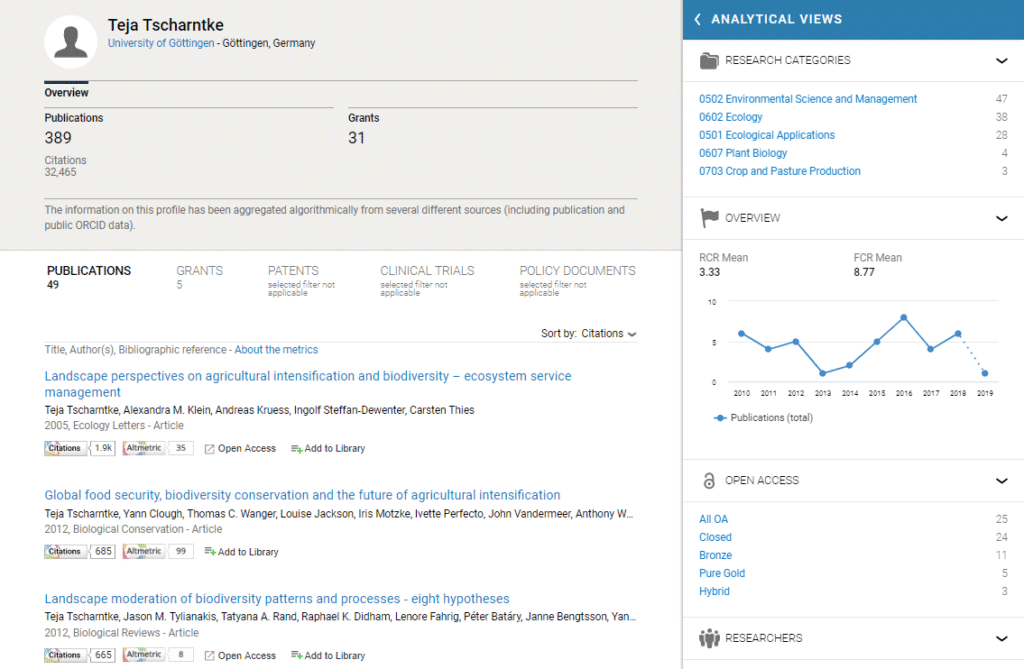
In Dimensions, publications are linked to other content types to provide a full view of the research landscape and easy exploration of the connections between relevant grants, clinical trials, patents and policy documents. A look at Professor Tscharntke’s profile page shows he has been awarded five grants by the German Research Foundation for this topic: the most recent – “Biodiversity and associated ecosystem services in small vs. large scale agriculture” – looks at land sparing (no agricultural developments in natural habitats) vs. land sharing (seeking a balance between high biodiversity and high yield).
Publications
Given the scale of the problem the planet faces, it’s no surprise that a topical search for “biodiversity” in Dimensions returns a large number of publications – 92,307 to be exact. If we search on “biodiversity and ecosystem services”, the number falls to 7,140 with the earliest published in 1970.
Sort these by citations, and we can see that the 2005 Science article “Global Consequences of Land Use” by Foley et al has received the highest number of citations to date (4,900). Compared to other publications in its field, it has received 374 times more citations than average – 35% of them were received in the past two years, which suggests it is still attracting a lot of interest.
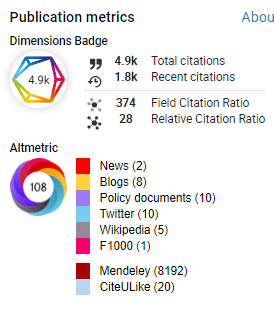
In contrast, the article that received the most online attention (with an Altmetric score of 4739), was a 2019 Biological Conservationpublication by Sánchez-Bayo et al exploring the threat to the insect population – “Worldwide decline of the entomofauna: A review of its drivers”.
Publications by year
As expected, publications related to biodiversity and ecosystem services have risen sharply in number over the past eight years (by more than 300%), from 281 in 2010 to 1,156 in 2018.
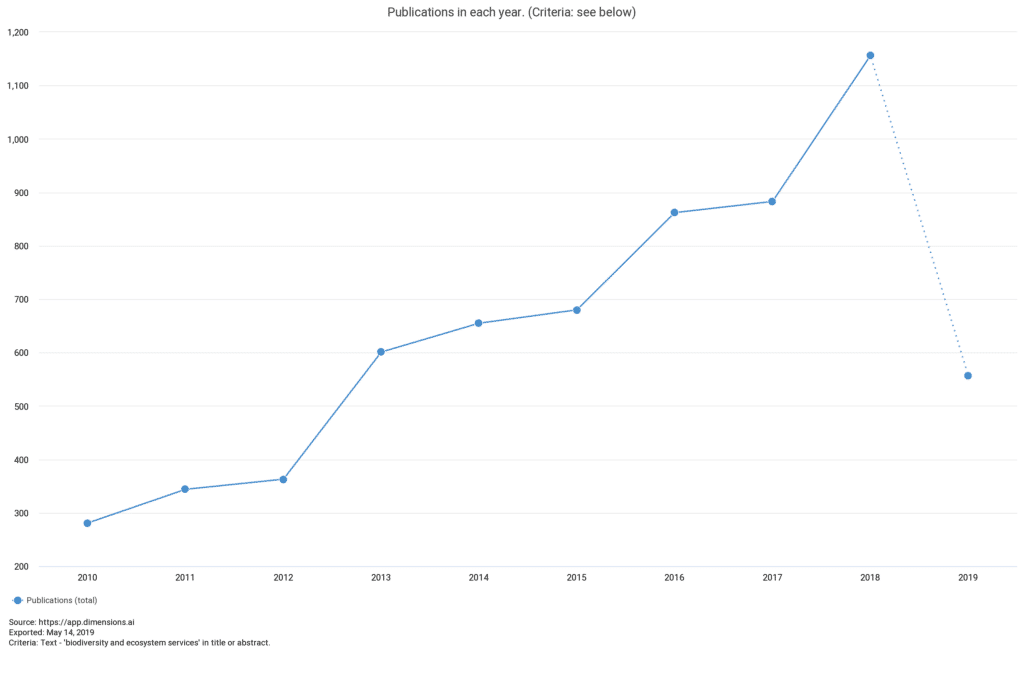
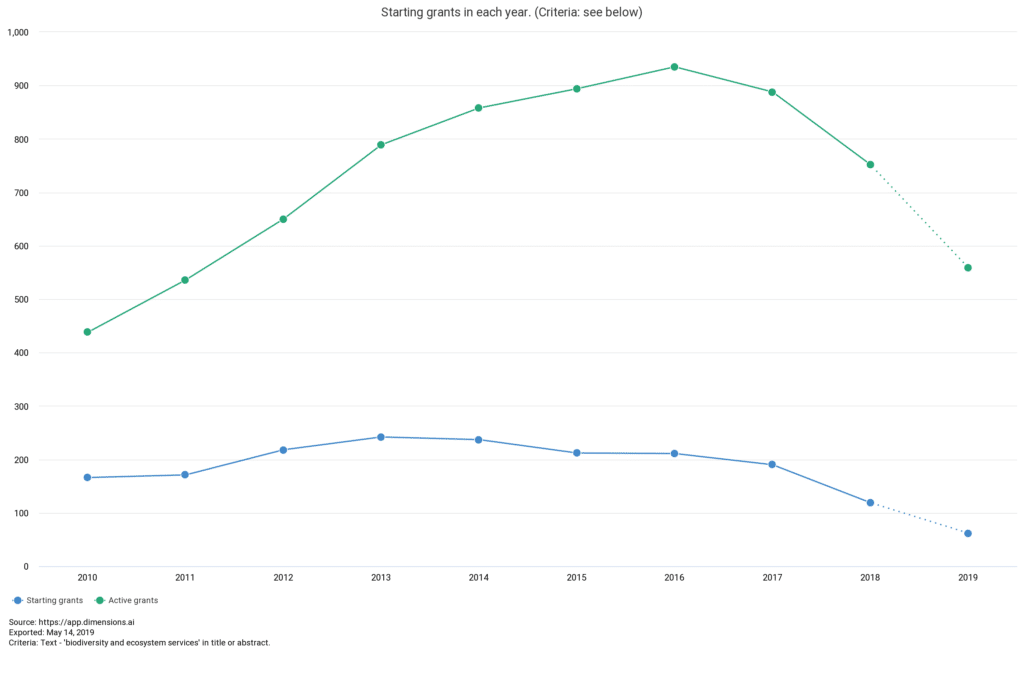
While publications may have peaked in 2018, as we can see in figure 4, active grant funding hit its highest point in 2016 (935) and is steadily descending. A result of tightening budgets?
The grant amounts awarded are high; for example, the Directorate for Geosciences in the US awarded the largest sum – 242 million euros – to the Texas A&M University System for a report on the management and operations of marine geoscience programs.
The top five funders to date are located around the globe:
- European Commission (EC) (Belgium): EUR 371.4 M
- Directorate for Geosciences (NSF GEO) (US): EUR 279.0 M
- Natural Environment Research Council (NERC) (UK): EUR 208.4 M
- Ministry of Business, Innovation and Employment (MBIE) (New Zealand): EUR 98.9 M
- Directorate for Biological Sciences (NSF BIO (US): EUR 92.6 M
Patents
Clicking on the patents tab reveals there has been one unique patent application. It was granted to Morgan Arena Irons, a 2017 graduate from the Duke University’s Nicholas School of the Environment. She has patented a closed environmental system that could sustain life on the surface of Mars or the Moon.
Policy documents
Of the 15 policy documents listed in Dimensions, more than half (eight) were published in 2016 and 2017. These largely explore the problems faced in particular geographic locations (e.g. Asia, East Africa and the Pacific Islands).
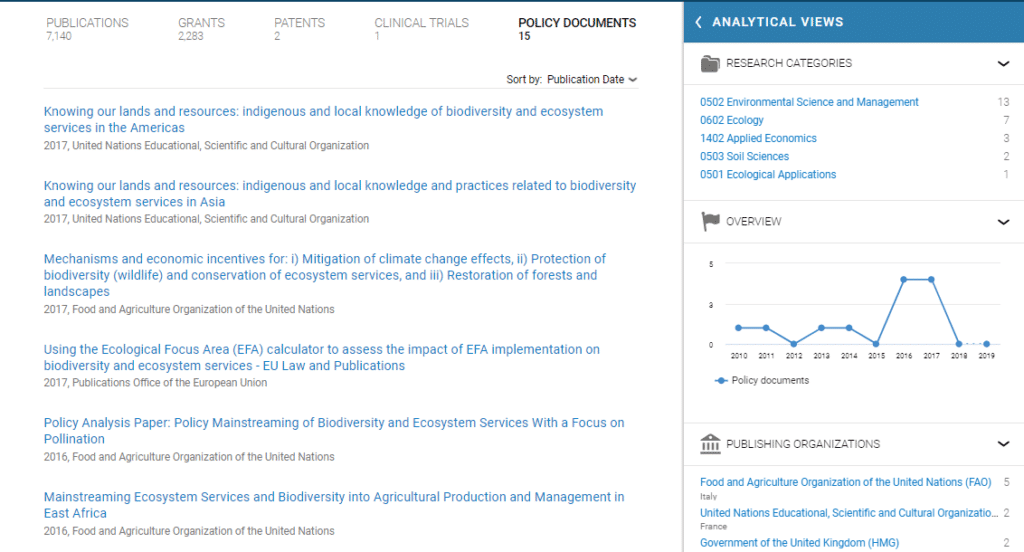
Bringing back the balance
Securing the future of the planet will require the combined efforts of all of us. The UN report states that while we are at “breaking point”, it is not too late to make a difference – but only if we start now at every level from local to global.
Some of the publications in Dimensions have some suggestions; for example, one study outlines four ways individuals can reduce personal emissions of greenhouse gas, including having less children. (10) A second suggests the creation of “biodiversity hotspots” to support the highest number of species at the lowest cost.(11) While a third believes improved communication about biodiversity is urgently needed after discovering that it currently receives up to eight times less media coverage than climate change.12)
High-performance robotics could also be a solution… at least in the case of pollination. One study looked at using flying robots equipped with animal hairs to counter the decline in honeybee populations. The article “Materially Engineered Artificial Pollinators” attracted quite a bit of online attention with an Altmetric score of 1269.(13)
Dimensions’ wide range of content allows you to gain new insights into your chosen topic. Feel free to reach out to the Dimensions team to learn more about the content scope and coverage and see how Dimensions can help you find the most relevant results faster.
References
- Ecosystem Changes, Biodiversity Loss and Human Well-Being
- Biodiversity Loss Threatens Human Well-Being
- Could consumption of insects, cultured meat or imitation meat reduce global agricultural land use?
- Weaker land–climate feedbacks from nutrient uptake during photosynthesis-inactive periods
- Discovery and resupply of pharmacologically active plant-derived natural products: A review
- Worldwide decline of the entomofauna: A review of its drivers
- Nonnative plants reduce population growth of an insectivorous bird
- Road mortality potentially responsible for billions of pollinating insect deaths annually
- Ornamental plants on sale to the public are a significant source of pesticide residues with implications for the health of pollinating insects
- The climate mitigation gap: education and government recommendations miss the most effective individual actions
- Biodiversity hotspots for conservation priorities
- Our House Is Burning: Discrepancy in Climate Change vs. Biodiversity Coverage in the Media as Compared to Scientific Literature
- Materially Engineered Artificial Pollinators
